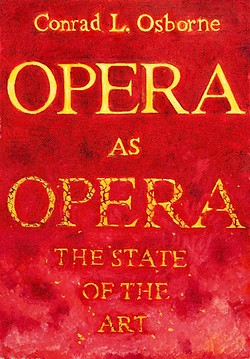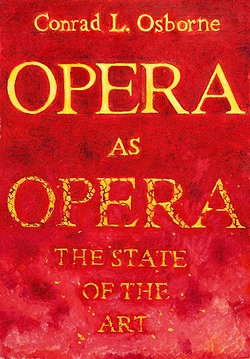|
Acclaim
Opera as Opera / The State of the Art
 Is opera on the brink of extinction? The short answer from this long book is yes—unless, that is, the end has come already. With Opera as Opera: The State of the Art, Conrad L. Osborne, elder statesman among American critics, sounds a blast as shattering as Gabriel's trumpet. His core concern is the canonical repertoire—"inexhaustible," once (but no longer) seemingly "imperishable"—of the "extended" 19thcentury ("E-19"), roughly Le Nozze di Figaro (1786) toTurandot (1926). Alas, that mighty stream went dry a hundred years ago. Gone, too, are the generations of great-voiced, charismatic personalities who kept the flame alive several decades longer. And who has filled the void? Quisling maestros fixated on orchestral perfectionism from which the pulse of drama is absent. Self-serving directors who overlay the creators' visions with arbitrary "concepts" of their own. Who among us can still believe in Aida or Parsifal? Readers may howl in protest or stick their heads in the sand, but can they refute what Osborne has to say? A vigorous 84, he remains sharp-eared, sharp-eyed, demanding, and responsive to a fault. He set to work on this magnum opus in 1998, spurred into action by Robert Wilson's Lohengrin for the Metropolitan Opera. His chosen mission: not to pick apart this show or that show but to diagnose the pathology of a culture. To complain that his concentration on events in New York is too narrow would be prejudice in reverse; the force of his argument lies in the universality of symptomatic details. Only by way of closing argument does Osborne expend his firepower on a remotely conventional "review"—or rather review essay, as unusual for depth as for word count, in blistering yet dispassionate dissent from the otherwise unanimous hosannas for Dmitri Tcherniakov's Prince Igor at the Met. Considerations Osborne brings to bear include cultural history, vocal technique, archival recordings, dramatic theory and practice, the sea changes wrought by microphone, camera, and supertitles... the list goes on. Yet except in the rare article-length footnote, he never loses sight of opera as opera—not a concert plus a story, not a play with music, not notes on a page, but live performance in a medium all its own, with expressive horizons transcending those of any sister art. In passing Osborne acknowledges with disarming candor the skepticism and resistance artists of every stripe contend with, whether because their public knows too little or has seen too much. Yet this is by no means the testament of a jaded old-timer. The specificity of praise he does offer validates his reservations. Osborne scores provocative points about the rising stock of Mozart's predecessors as well as the post-Puccini cavalcade of hopefuls who come and go without a trace. He deplores the disappearance of the contralto and frowns for cause on the male falsettists we call countertenors. In a coda, Osborne conjures up a utopian collective, complete with training program, dedicated to the E-19 legacy. And what would it look likr? Picture a beacon for interpreters proud to serve the vision of the creators, too proud to ape even the icons of yesteryear, adamant in their quest for a fusion of song and action that is true to the material, authentic to themselves, and convincing to audiences in our time. Osborne calls it the Dream-On Company. — Matthew Gurewitsch,
BeyondCriticism.com
|


 Back to List
Back to List